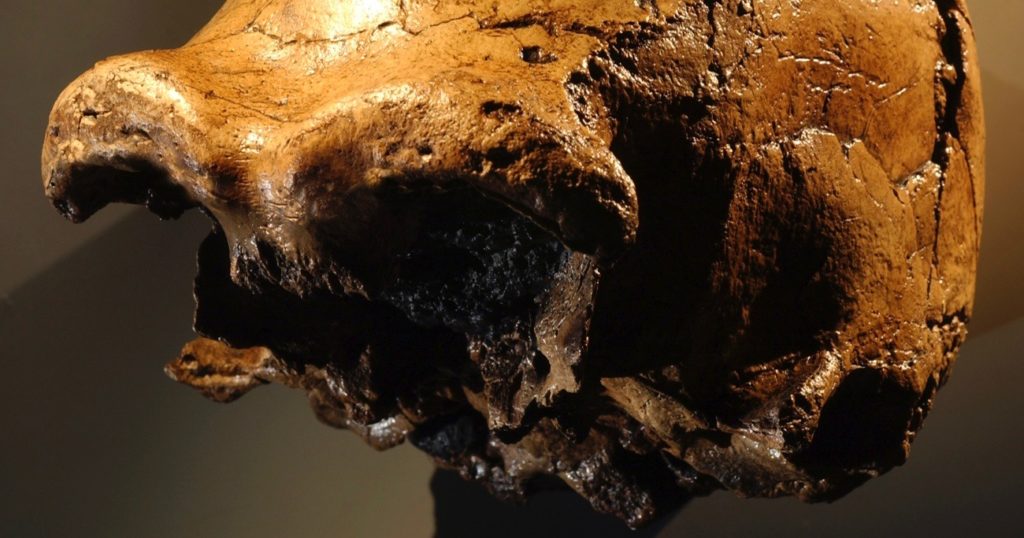 Evolution
Evolution
 Human Origins
Human Origins
Do Fossils Demonstrate Human Evolution? Let’s Consider the Technical Literature

Editor’s note: We are delighted to present a new series by geologist Casey Luskin asking, “Do Fossils Demonstrate Human Evolution?” This is the first post in the series, which is adapted from the recent book, The Comprehensive Guide to Science and Faith. Find the full series here.
Evolutionists commonly tell the public that the fossil evidence for the Darwinian evolution of our species, Homo sapiens, from ape-like creatures is incontrovertible. In 2009, Southern Methodist University anthropology professor Ronald Wetherington testified before the Texas State Board of Education that human evolution has “arguably the most complete sequence of fossil succession of any mammal in the world. No gaps. No lack of transitional fossils…So when people talk about the lack of transitional fossils or gaps in the fossil record, it absolutely is not true. And it is not true specifically for our own species.”1 According to Wetherington, human origins show “a nice clean example of what Darwin thought was a gradualistic evolutionary change.” But does the fossil record support such claims? Digging into the technical literature reveals a starkly different story.
Far from supplying “a nice clean example” of “gradualistic evolutionary change” that has “no gaps” or “no lack of transitional fossils,” the record shows a dramatic discontinuity between ape-like and human-like forms. Human-like fossils appear abruptly in the record, without clear evolutionary precursors, contradicting Darwinian expectations. The fossil record does not show that humans evolved from ape-like precursors.
The Fragmented Field of Paleoanthropology
The discipline of paleoanthropology studies the fossil remains of ancient hominins and hominids. Paleoanthropologists face many daunting challenges in their quest to explain human evolution from this hypothetical human/ape common ancestor. Their field is fragmented in multiple senses, making it difficult to confirm evolutionary accounts of human origins.
First, the fossil record is fragmented, and long periods of time exist for which there are few hominin fossils. So “fragmentary and disconnected” is the data, according to Harvard zoologist Richard Lewontin, that “[d]espite the excited and optimistic claims that have been made by some paleontologists, no fossil hominid species can be established as our direct ancestor.”2
The Specimens Themselves
A second challenge is the fragmented nature of the fossil specimens themselves. Typical hominid fossils consist of mere bone scraps, making it difficult to form definitive conclusions about their morphology, behavior, and relationships. As Stephen Jay Gould commented: “Most hominid fossils, even though they serve as a basis for endless speculation and elaborate storytelling, are fragments of jaws and scraps of skulls.”3
Flesh reconstructions of extinct hominins are likewise subjective. They often attempt to diminish the intellectual abilities of humans and overstate those of apes. One high school textbook4 caricatures Neanderthals as intellectually primitive even though they exhibited intelligence and culture, and casts Homo erectus as a bungling, stooped form — even though its skeleton is extremely similar to that of modern humans. Conversely, the same textbook portrays an australopithecine (which, in reality, had a chimp-sized brain) with gleams of human-like intelligence and emotion — a common tactic in illustrated books on human origins.5 The words of the famed physical anthropologist Earnest Hooton from Harvard University remain valid: “alleged restorations of ancient types of man have very little, if any, scientific value and are likely only to mislead the public.”6
The Problem of Sparse Data
Third, the field itself is fragmented. The sparse nature of the data, combined with the desire to make confident assertions about human evolution, often betrays objectivity and leads to sharp disagreements.7 After interviewing paleoanthropologists for a documentary, PBS NOVA producer Mark Davis recounted that “[e]ach Neanderthal expert thought the last one I talked to was an idiot, if not an actual Neanderthal.”8
Even the most established and confidently promoted evolutionary models of human origins are based on limited evidence. Nature editor Henry Gee conceded that the “[f]ossil evidence of human evolutionary history is fragmentary and open to various interpretations.”9
Next, “The Standard Story of Human Evolution: A Critical Look.”
Notes
- Ronald Wetherington, testimony before Texas State Board of Education (January 21, 2009). Original recording on file with author, SBOECommtFullJan2109B5.mp3, time index 1:52:00-1:52:44.
- Richard Lewontin, Human Diversity (New York: Scientific American Library, 1995), 163.
- Stephen Jay Gould, The Panda’s Thumb: More Reflections in Natural History (New York: Norton, 1980), 126.
- See Alton Biggs et al., National Geographic Society, Biology: The Dynamics of Life (New York: Glencoe/McGraw Hill, 2000), 442-443.
- Biggs et al., Biology: The Dynamics of Life; Esteban E. Sarmiento, Gary J. Sawyer, and Richard Milner, The Last Human: A Guide to Twenty-Two Species of Extinct Humans (New Haven, CT: Yale University Press, 2007); Richard Potts and Christopher Sloan, What Does It Mean to Be Human? (Washington, DC: National Geographic, 2010); Carl Zimmer, Smithsonian Intimate Guide to Human Origins (Toronto, Canada: Madison Press, 2005).
- Earnest Albert Hooton, Up from the Ape, rev. ed. (New York: Macmillan, 1946), 329.
- Paige Williams, “Digging for Glory,” The New Yorker (June 27, 2016), http://www.newyorker.com/magazine/2016/06/27/lee-berger-digs-for-bones-and-glory (accessed October 26, 2020); Donald Johanson and Blake Edgar, From Lucy to Language (New York: Simon & Schuster, 1996).
- Mark Davis, “Into the Fray: The Producer’s Story,” PBS NOVA Online (February 2002), http://www.pbs.org/wgbh/nova/neanderthals/producer.html (accessed October 26, 2020).
- Henry Gee, “Return to the Planet of the Apes,” Nature 412 (July 12, 2001), 131-132.
